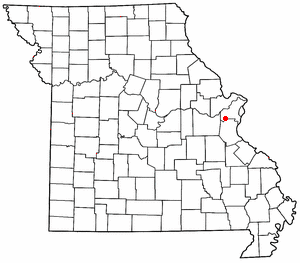Times Beach, Missouri
|
|
Times Beach, Missouri was a small town of 2,240 residents in St. Louis County, Missouri, 17 miles (27 km) southwest of St. Louis and two miles (3 km) east of Eureka, Missouri. The town was completely evacuated in the mid-1980s due to a dioxin scare that made national headlines. It was the largest civilian exposure to dioxin in the United States.
History
Times Beach was founded in 1925 on a floodplain along the Meramec River in a promotion by the now-defunct St. Louis Star-Times newspaper. A purchase of a 20 x 100 ft (6 by 30 m) lot for $67.50 included a six-month newspaper subscription.
In its early years, the town was primarily a summer resort, but the Great Depression, followed by gasoline rationing during World War II combined to make summer homes impractical, so the town became a community of low-income housing. In the years immediately prior to its evacuation, Times Beach had become a lower-middle class town. Prone to flooding throughout its history—its first buildings were built on stilts—the town experienced a devastating flood three weeks before an announcement by the Environmental Protection Agency (EPA) which led to the town's evacuation by 1985 and complete demolition by 1992. The town was disincorporated by executive order of Missouri governor John Ashcroft in 1985.
The site of Times Beach now houses a wild bird sanctuary and a 409 acre (1.7 km²) state park commemorating Route 66—the famous highway that stretched from Chicago, Illinois to Los Angeles, California and passed by the community—as well as the history of the Times Beach area. The park opened in 1999. In 2001, the EPA petitioned to have Times Beach removed from its Superfund list.
The Dioxin scare
Plagued with a dust problem in the early 1970s due to its 23 miles (37 km) of dirt roads and lack of pavement funds, the city of Times Beach hired waste hauler Russell Bliss to oil the roads in the town in 1971. From 1972 to 1976, Bliss sprayed waste oil on the roads at a cost of six cents per gallon used. The roads were later paved.
Bliss had also subcontracted for a subcontractor of Northeastern Pharmaceutical and Chemical Company (NEPACCO), which operated a facility producing hexachlorophene in Verona, Missouri. Some parts of the facility had been used for the production of Agent Orange during the Vietnam War, and the waste clay and water contained levels of dioxin some 2,000 times higher than the dioxin content in Agent Orange. Bliss claimed he was unaware that the waste contained dioxin.
Bliss had first used the technique of spraying waste oil to control dust in horse stables. When a March 1971 spraying resulted in the death of 62 horses, the owners of the stable suspected Bliss, who assured them it was just used engine oil. But Bliss had mixed the NEPACCO waste with waste oil. The owners followed Bliss' activities, and after other stables experienced similar problems, the Centers for Disease Control and Prevention began investigating, and in late 1979 a NEPACCO employee confessed the company's practice of handling dioxin. The government sued NEPACCO in 1980.
The EPA visited Times Beach in mid-1982, and in November 1982 stories began to appear in the press about the discovery of dioxin in Times Beach. Another soil sample was taken December 3, 1982, and the test result showed dioxin levels some 300 times higher than the one part per billion generally considered to be safe.
On December 23, 1982, the EPA announced it had identified dangerous levels of dioxin in Times Beach's soil. Panic spread through the town, with many illnesses, miscarriages, and animal deaths attributed, rightly or wrongly, to the dioxin. President Ronald Reagan formed a dioxin task force. At the time, dioxin was hailed as "the most toxic chemical synthesized by man," based on its extreme toxicity in guinea pigs.
On February 23, 1983, the EPA announced the town's buyout for $32 million. Later, PCBs were also found in Times Beach soil. By 1985, the town was evacuated except for one elderly couple who refused to leave, and the site was quarantined. Residents were shunned in their new communities by people who feared the effects of exposure to dioxin were contagious. Many of the town's citizens sued Bliss, NEPACCO, and its various subcontractors. Although the ethics and legality of Bliss' practices has been questioned, Bliss was never implicated or convicted of any crime.
About 265,000 tons of contaminated soil and debris from Times Beach and 28 other sites in eastern Missouri was incinerated from March 1996 to June 1997 in an incinerator built and operated on the site by Syntex, the parent company of NEPACCO. The cleanup cost the government a total of $110 million, $10 million of which was reimbursed by Syntex. After the cleanup, the incinerator was dismantled and the site was turned over to the State of Missouri.
Subsequent research on the effects of dioxin on humans and other mammals has led some experts to question whether the evacuation of the town was necessary, sometimes citing the example of Seveso, Italy, the site of a disaster in 1976 that exposed residents to larger levels of dioxin than those of Times Beach and whose subsequent cleanup allowed the city to continue to exist.
Today, the land that was once Times Beach is now Route 66 State Park. One building from the town still exists: the park's visitor center was once a roadhouse from Times Beach's glory days, and was the EPA's headquarters for the area.

